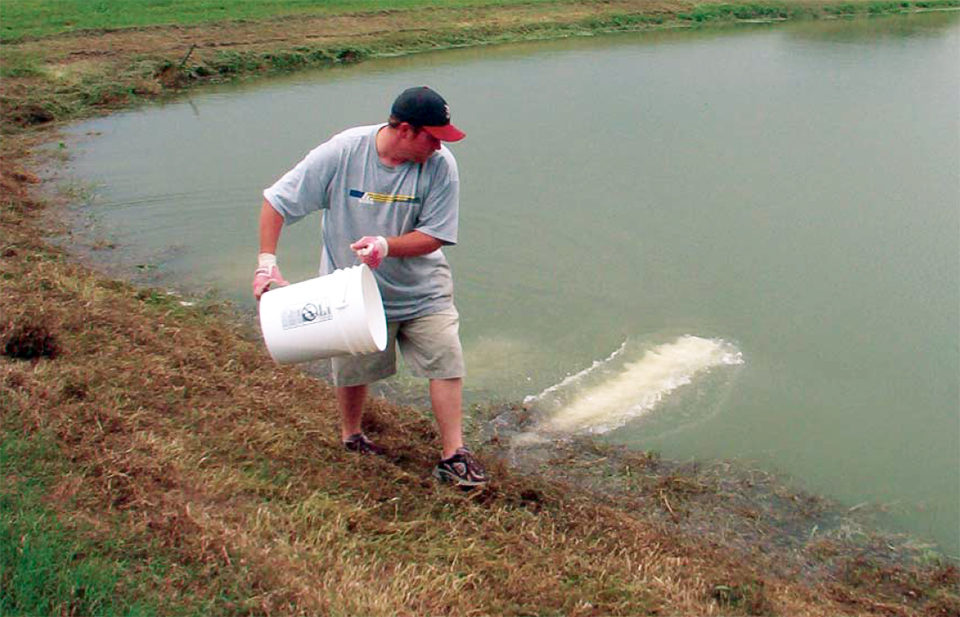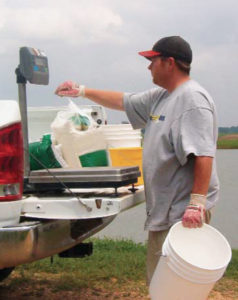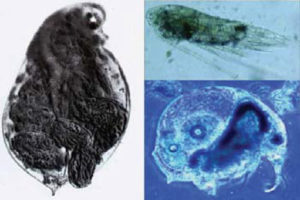Catfish fry stocking decision should be based on abundance of cladocerans, copepods

Although channel catfish culture is the largest aquaculture industry in the United States, little research has been conducted on improving the efficiency of the fry-to-fingerling stage of production. Survival of fry after stocking into nursery ponds is unpredictable and highly variable. More effective pond fertilization practices and zooplankton population monitoring may be ways to improve the efficiency of this stage of catfish production.
Zooplankton selection
Recent pond and laboratory experiments at the National Warmwater Aquaculture Center in Stoneville, Mississippi, USA, determined the zooplankton selectivity of channel catfish fry. Fry were stocked into experimental ponds and aquariums with differing zooplankton communities and allowed to forage for 24 hours before sampling. Stomach contents were removed from the sampled fry and examined microscopically. Zooplankton taxa and quantities consumed were compared with the overall taxa and numbers of zooplankton available in the water.
Although the taxonomic compositions of the zooplankton communities were different, fish in all trials showed the same zooplankton preferences (Table 1). Channel catfish fry preferred large cladocerans such as Daphnia, Moina and Sida to all other groups of zooplankton. Although the cladocerans were rare in the zooplankton samples taken, the fry actively sought them.
Mischke, Zooplankton preferences of swim-up channel catfish, Table 1
| Zooplankton Group | Rank | Fry Behavior |
|---|
Zooplankton Group | Rank | Fry Behavior |
|---|---|---|
| Large cladocerans | 1a | Preferred |
| Copepods | 2bc | Neutral |
| Small cladocerans | 3c | Avoided |
| Copepod nauplii | 4d | Not consumed |
| Rotifers | 4d | Not consumed |
The copepods Diaptomus, Halicyclops and Cyclops were generally consumed in the same proportions in which they occurred in the water. Small cladocerans, including Bosmina, Alona and Chydorus, were consumed by the fry, but avoided if larger prey were present. Rotifers and copepod nauplii, although abundant in all experiments, were never consumed by the fry.
Zooplankton nutritional value
Zooplankton are assumed to play a major role in catfish nutrition after fry are stocked into ponds, whereas uneaten prepared feeds serve as fertilizer for natural pond productivity. Although some studies have determined the nutritional value of specific zooplankton – typically cultured zooplankton – the authors wanted to determine the nutritional value of the wild zooplankton consumed by channel catfish fry and small fingerlings.
Eight ponds were fertilized for one month, and then large zooplankton (copepods, cladocerans, and ostracods) were collected from each pond. The zooplankton were identified and analyzed for chlorophyll and carotenoid pigment composition, crude protein and fat, amino acids, fatty acids, vitamins, and minerals.
Protein and fat
The zooplankton contained 65 percent crude protein on a dry matter basis, which exceeds the 58 percent protein requirement for channel catfish fry raised from swim-up to about 1 week of age. The minimum protein requirement appears to decline with fish growth and size to about 55 percent to 46 to 50 percent at 3 to 5 grams. The zooplankton under study contained about 9 percent fat, a level slightly lower than in typical catfish starter diets and higher than in typical fingerling feeds.
Minerals and vitamins
The results of mineral analyses from pond zooplankton samples are presented in Table 2. All analyzed minerals exceeded the requirements determined for catfish fingerlings. Analysis of composite vitamin samples (Table 2) showed the zooplankton were excellent sources of niacin and vitamin E, with concentrations several times higher than the requirements for fingerlings.
Mischeke, Dry-matter mineral and vitamin composition, Table 2
| Zooplankton Content | Requirement |
|---|
Zooplankton Content | Requirement | |
|---|---|---|
| Minerals | ||
| Calcium (%) | 3.30 | None* |
| Phosphorus (%) | 1.01 | 0.03-0.04 |
| Copper (ppm) | 42.40 | 4.80 |
| Iron (ppm) | 1,000.00 | 20.00 |
| Manganese (ppm) | 135.00 | 2.40 |
| Selenium (ppm) | 0.80 | 0.25 |
| Zinc (ppm) | 100.00 | 20.00 |
| Vitamins (ppm) | ||
| Folic acid | 2.20 | 1.50 |
| Niacin | 107.50 | 7.40-14.00 |
| Pantothenic acid | 14.00 | 10.00-15.00 |
| Vitamin B6 | 6.00 | 3.00 |
| Ascorbic acid | 18.00 | 11.00-60.00 |
| Vitamin E | 109.00 | 25.00-50.00 |
| Thiamin | 2.00 | 1.00 |
| Riboflavin | 17.00 | 6.00-9.00 |
Amino and fatty acids
All indispensable amino acids were in excess of the requirements for fingerling catfish. Assuming the digestibility of the zooplankton was 80 percent or greater, all amino acid requirements for the fingerlings were met.
The 16:0, 18:1, and 20:5 omega-3 were the dominant fatty acids. Channel catfish do not appear to be as sensitive to fatty acid deficiency as some other species, but require omega-3 highly unsaturated fatty acids (HUFAs) for optimum growth. It appears that 1-2 percent dietary linolenic acid (18:3 omega-3) or 0.75 percent omega-3 HUFAs will satisfy the omega-3 fatty acid requirement of fingerling catfish.
The omega-3 HUFAs from zooplankton in the study averaged 18 percent of total fat or 1.6 precent of dry matter, which exceeded the requirement. The large size fraction of the zooplankton compared favorably to other omega-3 HUFA sources.
Phytopigments
Phytopigments (chlorophylls and carotenoids) in the zooplankton were also analyzed. Carotenoids indicate the taxa of algae consumed by zooplankton, but may also be biologically important for fry. Carotenoids may influence fry survival and immunity, and have an antioxidant role.
Chlorophyll a was the most abundant chlorophyll detected. The carotenoids chinenone, canthaxanthin, and β-carotene were also abundant in the zooplankton. Echinenone and canthaxanthin indicated grazing on blue-green algae.
Pond fertilization research

Previous recommendations for fertilization of channel catfish nursery ponds were the result of research done in Alabama during the 1930s and 1940s. A common recommendation is to fertilize with high-phosphorus inorganic fertilizer at 561 to 1,122 grams per hectare every two days until a bloom develops. Also, some sources recommend applications of organic fertilizer (rice bran, cottonseed meal, or alfalfa pellets) at up to 280 kilograms per hectare, followed by weekly applications at half the initial rate.
To determine if such recommended fertilization practices are appropriate for northern Mississippi, phytoplankton and zooplankton responses to both organic and inorganic fertilization in channel catfish nursery ponds before fish stocking were evaluated. The authors also evaluated the responses to fertilizers in newly constructed versus established catfish nursery ponds.
In 2001, three control ponds did not receive fertilizer. Three additional ponds received an initial application of 224 kilograms per hectare cottonseed meal, 56 kilograms per hectare calcium nitrate, and 5.6 l per hectare triple superphosphate. The fertilized ponds also received weekly applications of 28 kilograms per hectare cottonseed meal and twice-weekly applications of 28 kilograms per hectare calcium nitrate and 1.87 l per hectare triple superphosphate for four weeks.
Few differences were apparent between the fertilized and control ponds. Although phosphorus levels were higher in the fertilized ponds, algal populations were not different among all the ponds. Nitrogen levels were similar in all ponds, and the preferred zooplankton populations were unchanged by fertilization.
In 2002, 26 ponds were studied. Sixteen ponds were newly constructed and 10 were previously used for fish production for several years. Within each pond age group, treatments of no fertilizer additions, organic fertilizer only, inorganic fertilizer only, or a combination of organic and inorganic fertilizers were assigned.
The organically fertilized ponds received an initial application of 84 kilograms per hectare cottonseed meal followed three days later by 56 kilograms per hectare of the meal. Thereafter, 28 kilograms per hectare was added twice per week for three weeks. Inorganically fertilized ponds received an initial application of 44.8 kilograms per hectare urea and 5.6 l per hectare triple superphosphate, followed by twice-weekly applications of 22 kilograms per hectare urea and 2.8 l per hectare triple superphosphate for three weeks.
Compared to levels in the control ponds and organic-only treatments, nitrogen was higher in the older ponds and those that received inorganic fertilizer and the combined organic and inorganic fertilizer treatments. Phosphorus was higher in the old ponds and in all that received inorganic fertilizer.
Chlorophyll a, zooplankton

Chlorophyll a was higher in the inorganic and inorganic plus organic treatments compared to the controls and organic-only treatments. The control ponds and organically fertilized ponds – both old and new – were similar in chlorophyll a concentration and decreased over the study. Chlorophyll a in new ponds fertilized with inorganic or combination fertilizers was low and remained constant throughout the study. Old ponds fertilized with inorganic only or both inorganic and organic fertilizers increased initially in chlorophyll a, then decreased throughout the second half of the study.
The three groups of zooplankton important for channel catfish are copepods, cladocerans, and ostracods. Copepod numbers were higher in old ponds and those fertilized with both organic and inorganic fertilizer. In all fertilizer treatments, copepod numbers increased over the study, with peak numbers reached 14 to 24 days after filling.
Cladoceran numbers were not significantly different between old and new ponds, but were higher in ponds fertilized with inorganic fertilizer as compared to all other treatments. In inorganically fertilized ponds, cladocerans reached peak numbers 17 days after filling in both new and old ponds. Ostracods were more numerous in older ponds, but no differences occurred among fertilizer treatments.
Recommendations
Although some species of fish fry initially consume small zooplankton, channel catfish fry were found to consume the largest zooplankton groups immediately at swim-up. The stocking decision on which pond in which to stock catfish fry should therefore be based on the abundance of large cladocerans and copepods present, rather than total zooplankton abundance.
North Mississippi nursery ponds are primarily nitrogen limited. This is in contrast to previous thought that phosphorus is the key ingredient in fertilizer. Although the 2002 protocol resulted in significant differences among treatments, even higher nitrogen applications may be beneficial, especially in new ponds. Organic fertilizers had little effect on primary productivity or zooplankton populations. Higher rates of organic fertilizer may eventually produce responses, but may also reduce water quality.
The authors suggest using only established ponds for fry culture, filling ponds one or two weeks before stocking, and applying inorganic fertilizer at an initial rate of about 20 kilograms per hectare nitrogen and 1.1 to 2.2 kilograms per hectare phosphorus, followed by subsequent applications of half the initial rate for three or four weeks. If newly constructed ponds are used, higher fertilizer rates are probably necessary to achieve the same response.
(Editor’s Note: This article was originally published in the June 2006 print edition of the Global Aquaculture Advocate.)
Now that you've finished reading the article ...
… we hope you’ll consider supporting our mission to document the evolution of the global aquaculture industry and share our vast network of contributors’ expansive knowledge every week.
By becoming a Global Seafood Alliance member, you’re ensuring that all of the pre-competitive work we do through member benefits, resources and events can continue. Individual membership costs just $50 a year. GSA individual and corporate members receive complimentary access to a series of GOAL virtual events beginning in April. Join now.
Not a GSA member? Join us.
Author
-
Charles C. Mischke, Ph.D.
Mississippi State University
Thad Cochran National Warmwater Aquaculture Center
P.O. Box 197
Stoneville, Mississippi 38776 USA
Tagged With
Related Posts

Health & Welfare
Antigens provide immunity against ich in channel catfish trials
Vaccination against the Ich parasite is an alternative to chemical treatment. Fish develop a humoral immune response to trophont antigens, with the degree of protection related to the immunizing doses of trophonts used.

Innovation & Investment
Assessing coloration in channel catfish fillets
Because consumers look at color to gauge quality of catfish fillets, the authors developed a digital photography measurement method to assess yellowness.

Health & Welfare
Biofloc technology reduces common off-flavors in channel catfish
In studies that used biofloc systems to culture channel catfish, culture tanks were susceptible to episodes of geosmin and 2-methylisoborneol and subsequent bioaccumulation of off-flavors in catfish flesh.

Health & Welfare
Blue catfish outproduce channel catfish under low-D.O. conditions
Although there is increasing interest in blue catfish, a potential disadvantage of the fish when compared to channel catfish is their reported poorer tolerance of low dissolved-oxygen concentrations.


